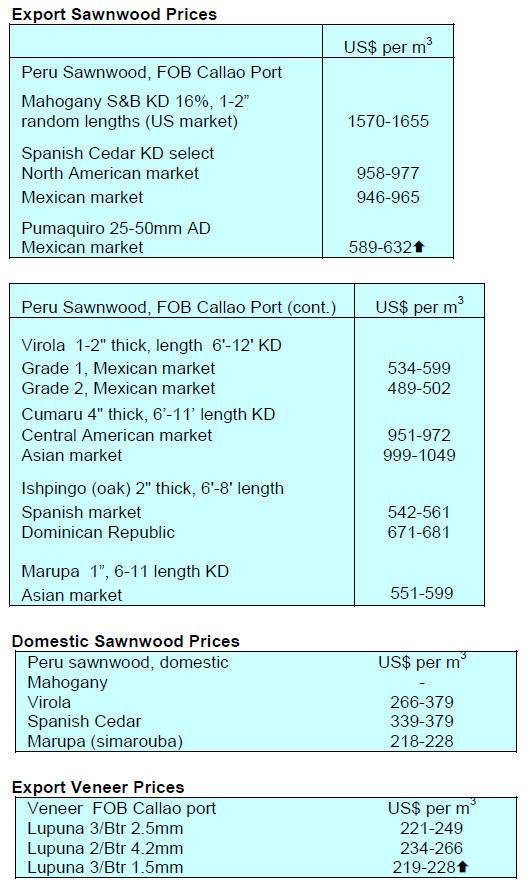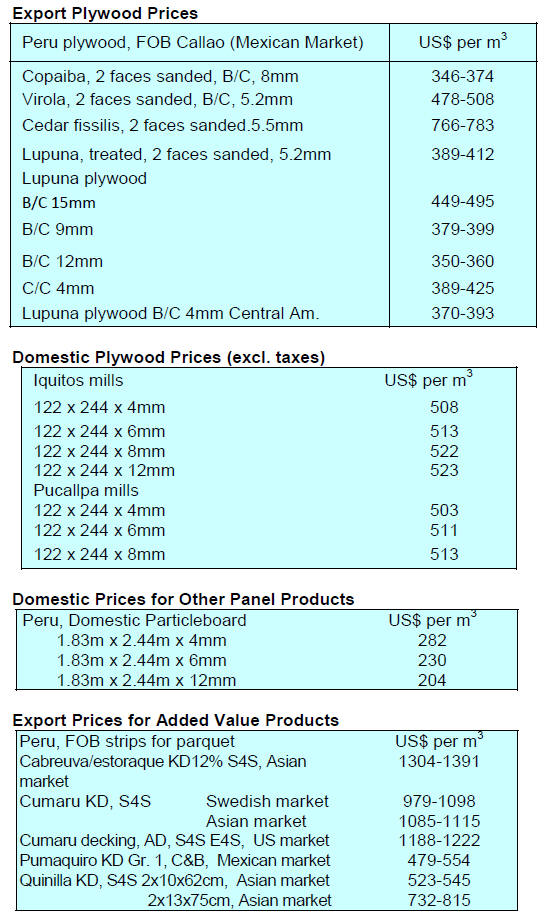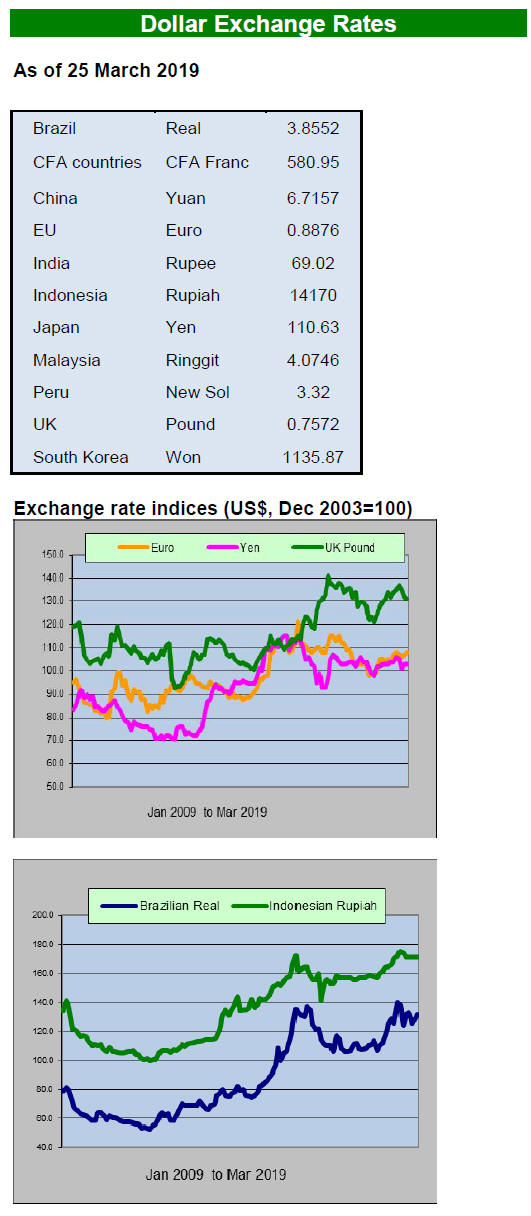3.
MALAYSIA
Agencies harmonise support for
industry
The three timber agencies within the Ministry of Primary
Industries; the Malaysia Timber Industry Board (MTIB);
the Malaysia Timber Council (MTC) and the Malaysian
Timber Certification Council (MTCC) recently held a joint
meeting to harmonise ongoing and proposed programmes
for the timber sector and formulate effective strategies to
achieve the national wood product export target of RM25
billion by 2020.
The focus of attention was on the sustainable supply of
raw materials, raising productivity and improving the
marketability of Malaysian wood products.
On raw material supply the group determined that success
in improving availability depended very much on land
being available for plantations, collaboration between
agencies and undiminished maintenance of forest
certification.
The importance of developing high valued-added products
and increasing productivity through the development of
automation and mechanisation was also addressed. It was
determined that a holistic approach throughout the supply
chain, from raw material supply, availability of skilled
workers, automation and mechanisation, product designs,
engineered timber products would be required.
Critical to success in improving the marketability of wood
products was ability of exporters to comply with market
regulations and certification. The report of this joint
review will be presented to the Minister of Primary
Industries.
Ethnic groups confront workers clearing forest
The Sarawak Forestry Department has been told to
suspend a permit issued to an oil-palm company to clear
forest on the fringes of Mulu National Park.
It has been reported that this instruction came from Mulu
State Assemblyman, Gerawat Gala, because of a
confrontation between groups of Penan, Berawan and
Tering with plantation company workers. Felling has
stopped according to the Sarawak media and the land is
being guarded by the ethnic groups.
For more see: https://www.thestar.com.my/metro/metronews/
2019/03/22/logging-activity-suspended/
Sabah Chief Conservator defends log export ban
Chief Conservator of Forests, Mashor Mohd Jaini, said the
State Government’s log export ban should spur the
development of the wood-based industry in the State. He
said the aim of the State government was to see the
production of a wide range of high value wood products to
support economic development and the creation
employment opportunities.
Mashor said harvesting in the natural forests contributed
around 50% of State revenue in past years but this is not
the case now as production from the natural forest has
fallen sharply.
The Sabah media has reported the Conservator as saying
“To ensure the forestry sector remains relevant as one of
the main sources of revenue for socio-economic
development, the State Government has committed to
manage the State’s forest resources in line with the
principles of sustainable forest management in accordance
with international standards.”
See: http://www.dailyexpress.com.my/news/132786/log-exportban-
empowers-the-wood-based-industry/
In 2018, Sabah exported 151,553 cu.m of sawntimber
worth RM289 million; 491,207 cu.m of plywood worth
RM1,048 million and 63,947 cu.m of veneer worth
RM105 million.
Plywood prices
Traders based in Sarawak reported the following export
prices in mid-March:
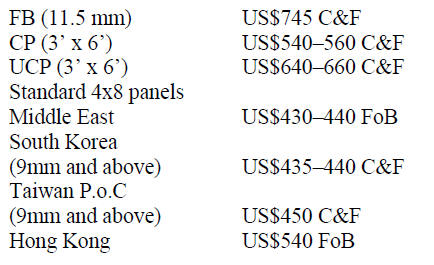
4.
INDONESIA
President declares SVLK
legality verification only
necessary for upstream sectors
The Indonesian President, Joko Widodo, responded
positively to complaints from furniture entrepreneurs
about the national timber legality verification system
(SVLK) and promised to simplify this system.
This was in response to statements from the Chairman of
the Indonesian Furniture and Handicraft Industry
Association (HIMKI), Soenoto, who pointed out that it is
enough that SVLK verification is conducted for upstream
raw material sourcing. If downstream enterprises also have
to secure SVLK certification this is a duplication, it
increases costs and undermines competiveness of
downstream companies.
The media in Indonesia have reported that the President
reaffirmed that this will be dealt with and that SVLK
certification for upstream processes will be all that is
required. It is reported that he called on his administration
to simplify SVLK legality verification to encourage local
businesses to invest and increase exports.
https://www.medcom.id/ekonomi/mikro/VNxqyrJb-presidensederhanakan-
sistem-verifikasi-legalitas-kayu
https://news.okezone.com/read/2019/03/13/337/2029583/turutipengusaha-
mebel-jokowi-pangkas-regulasi-sistem-verifikasilegalitas-
kayu
In other news, President Joko Widodo, in answer to
questions after reviewing the International Furniture Expo
(IFEX) 2019, heaped praise on the county’s furniture
producers saying he was impressed with progress made in
terms of design and quality pledging to support R&D in
technology, design and also on raw material issues.
He acknowledged that there remain many issues to be
addressed such as the supply of raw materials at
competitive prices as well as the sustained availability of
raw materials.
Furniture and craft entrepreneurs should diversify
export markets
Furniture and craft entrepreneurs who are members of the
Indonesian Furniture and Craft Entrepreneurs Association
(Asmindo) hosted the Jogja International Furniture and
Craft Fair (JIFFINA) in March.
Speaking at the opening the Chairman of JIFFINA 2019,
Endro Wardoyo, said that entreprenuers need to be
developing markets outside their traditional US market.
He continued by pointing out that there is huge potential in
new markets in the EU such as the Netherland, Germany,
France, Britain and Italy. In addition markets in Japan and
South Korea should be examined.
At JIFFINA 2018 the target for sales was US$64 million
but at the recent show it was announced that annual sales
of US$80 million was the target.
The Director General of Small and Medium Industries,
Gati Wibawaningsih, said that the Ministry of Industry
will continue to encourage expansion of the small and
medium industries nationally as they play a vital role in
employment generation.
In related news, Airlangga Hartarto, Minister of Industry,
said the government continues to support the performance
of labor-intensive and export-oriented manufacturers in
order to strengthen the structure of the national economy.
According to Airlangga, the development of the domestic
furniture industry has great prospects as it has available
abundant wood and rattan raw materials.
“Lightwood’ export promotion in Vietnam
The Ministry of Trade will seek ways to help
manufacturers boost exports of processed ‘lightwood’ to
Vietnam. The first step was made when a Business-to-
Business event was held in Ho Chi Minh City. The aim of
this was to increase the interest of importers in processed
Albizia falcataria and Jabon wood (collectively traded as
lightwood).
The Director, Export Development in the Ministry of
Trade, Arlinda, said that demand for wood products in
Vietnam is surging and this is a good opportunity for
Indonesain exporters of ‘lightwood’ products.
Arlinda reported that Indonesia's ‘lightwood’ exports to
Vietnam in 2017 were valued at just US$10.48 million but
this could be increased substantially.
The promotional effort in Vietnam resulted in a
memorandum of understanding between Indonesian
companies with members of the association of Vietnamese
Handicraft and Wood Industry Association (HAWA) and
the Binh Duong Furniture Association (BIFA) aimed at
furthering business ties.

5.
MYANMAR
MTE responds to EIA report
The Frontier Myanmar, an English-language weekly
magazine, recently interviewed U Khin Maung Kyi,
Deputy General Manager at the Myanma Timber
Entreprise (MTE) on the EIA allegations of corruption in
the timber sector.
The text of the interview can be found at:
https://frontiermyanmar.net/en/myanma-timber-enterprise-notworried-
about-eia-corruption-report
EUTR Competent Authority briefing by MTCC
During a recent meeting in Europe representatives from
the Myanmar Forest Certification Committee (MTCC)
provided some background information to several EUTR
Competent Authorities on the Myanmar timber sector.
(EUTR Competent Authorities are the authorities in EU Member
States responsible for implementation of the EU Timber
Regulation).
The following is an extract from a Hand-out distributed by
Myanmar. The document will be available on the MTTC
website http://www.mfcc.org.mm/.
“When we examine developments in Myanmar, we should
think in terms of six main periods since we became an
independent state in 1948.
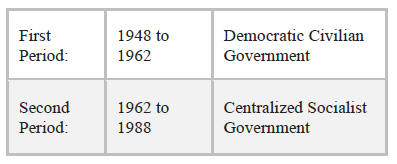
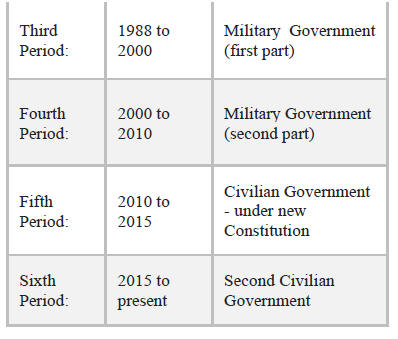
The majority of deforestation is believed to have
happened
during the fourth period as a result of the isolation of
Myanmar due the political situation.
During the fifth period we witnessed the start of
remarkable changes in the forestry sector, and at the close
of that period on April 1 2014 Myanmar introduced the
Export Logging Ban.
Changes have continued into the sixth period, under the
current NLD-led government, and one-year moratorium in
the whole country 2016-17 (ten-year moratorium in Bago
Mountain Range where the environmental impact would
be severe) In addition, the Myanmar Government has
significantly determined not to depend on the income of
natural resources and placed a priority on forest
conservation.
Such positive developments are due to many facts – open
and closed critics in both soft and hard approaches from
both outside and inside the country.
At this juncture there is one extremely important fact –
there are many professional people in the Myanmar’s
forestry sector. They have not been happy and have been
deeply upset about the negative impact on the production
forestry by the people in power.
Such professional people and non-professionals who love
the forest have tried in every possible ways to stop the
drivers of the negative impacts and to move towards the
right direction. They have been applying a soft power
approach and considering broad issues within forestry
such as economic and livelihoods development, while a
few INGOs, who value only the environment, have been
applying hard power approach.
Role of MFCC
A Timber Certification Committee-Myanmar (TCC-M)
was formed in 1998. It was reformed the Myanmar Forest
Certification Committee (MFCC) in 2013, with a new
Committee assigned in 2018.
MFCC formulated MTLAS based on ASEAN and ITTO
and MFCC is fully convinced that MTLAS is required and
is the foundational solution to strengthen Myanmar timber
legality and to meet the international bench mark.
MFCC conducted the MTLAS Gap Assessment Project
with the assistance of EU-FLEGT-FAO Programmed
carried out by an independent international assessor. The
Gap Assessment Project recommended four key areas to
be strengthened to support the credibility of timber
traceability and legality:
Since the GAP report was released in 2017 MFCC and
others in the forestry sector have been working hard to
close the gaps.”
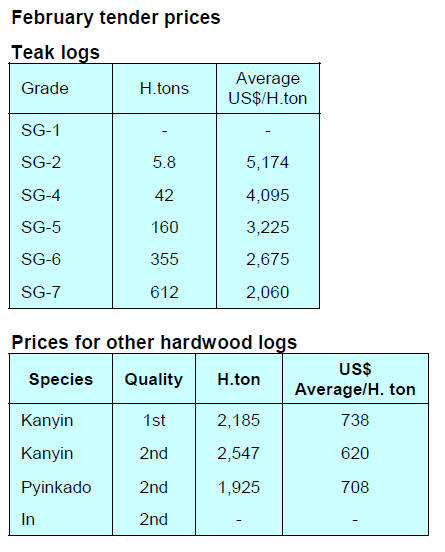
6. INDIA
India’s SFM certification recognised
The Indian media has reported that the Programme for
Endorsement of Forest Certification (PEFC) Council has
endorsed the Certification Standard for Sustainable Forest
Management developed by the Network for Certification
and Conservation of Forests (NCCF), an Indian non-profit
organisation.
The NCCF was established by the private sector, the
government and non-profit organisations with the aim of
setting standards for certifying sustainable management in
India’s forests.
Vijai Sharma, NCFF chairman, said India’s forest deliver
essential ecological, economic and social services and
provide direct livelihood for around 275 million forest
dependent people in the country.
https://www.downtoearth.org.in/news/forests/india-s-first-forestcertification-
scheme-gets-global-recognition-63678
Woodworking, one of the fastest growing sectors in
the economy
The organisers of DelhiWood 2019 have reported that
over 500 exhibitors from 35 countries exhibited at the
latest fair held 13-16 March at the Expo Centre and Mart
in Greater Noida making it the biggest woodworking
industry show in India.
The woodworking industry is one of the fastest growing
sectors of the Indian economy and the World Bank has
said output from India's organised furniture industry is
expected to grow 20% annually for the next few years.
The aim of DelhiWood 2019 is to provide the
technological support to spur this growth.
https://www.business-standard.com/article/news-ani/india-sorganised-
woodworking-industry-projected-to-cross-usd-32-
billion-in-2019-119031400678_1.html
Multiple media sources in India are quoting a World Bank
study which says India’s ‘organised‘ furniture sector could
be worth US$32 billion in 2019 boosted by online sales.
The government’s ‘Housing-for-All‘ initiative, the
development of smart cities and growth in the tourism and
hospitality sectors will also drive furniture demand.
However, when assuming power five years ago, the new
government promised that every Indian will have a home
to live in by 2022 but, while millions of new homes have
been planned and approved to deal with India's
homelessness problem, many remain to be built. This
issue, amongst others, is at the core of campaigning for the
upcoming election.
http://www.indiawood.com/indiawood-2018-marketscenario.
php
https://www.f9furnichair.in/blog-info-furniture-industry-in-indiathe-
rising-dawn-settling-dusk
Growth depends on increasing skilled labour force
India is the world’s fastest growing economy and the
government of India has been working to transform the
country into a competitive, high-growth, high productivity
middle-income country.
A decade ago the Indian economy was largely agro-based
but there has been a marked shift as manufacturing and
services have expanded. To progress their aim the
government recognises that a lack of skilled workers could
undermine further diversification of the econmy.
More than 12 million youth between 15 and 29 years of
age are expected to enter India’s labor force every year for
the next two decades.
The government’s recent skill gap analysis concludes that
by 2022, another 109 million skilled workers will be
needed in the 24 keys sectors of the economy. According
to a National Skill Development Council (NSDC) report,
India’s furniture and furnishings industry will need 11.3
million skilled workers by the year 2022.
https://nsdcindia.org/sites/default/files/Furniture-Furnishing.pdf
and
http://www.worldbank.org/en/news/feature/2017/06/23/skillingindia
At the recent ‘Construction Technology India 2019’
conference innovative construction technologies in the real
estate and construction sectors were discussed with the
aim of supporting the vision of the government to provide
homes for all Indians by 2022. This presents a major
challenge and will require a movement towards new
construction technologies.
To achieve this vision, the Ministry of Housing and Urban
Affairs founded the “Global Housing Technology
Challenge-India (GHTC-India) which is charged with
identifying appropriate construction technologies applied
around the world that are environmentally sound,
economic and disaster-resilient.
The 2-day long Expo cum Conference provided a unique
opportunity for B2B interactions with global as well as
Indian industry partners and explore further areas of
collaboration, signing of MoUs and work in India on
housing construction sector. CREDAI is the Knowledge
Partner at Global Housing Technology Challenge India.
See CREDAI press release at:
https://credai.org/press-releases/credai---knowledge-partner-atglobal-
housing-technology-challenge-india-ghtc-india-ministryof-
housing-and-urban-affairs
Plantation teak prices
The Rupee continues to strengthen against the US dollar.
The US dollar is the currency used in supply countries to
price export teak such that the firmer Rupee is good news
for importers. However, with the general consensus
amongst importers that further strengthening is likely they
are biding their time hoping to conclude contracts at an
even better exchange rate than the current Rp69 to the US
dollar.
C&F prices for plantation teak landed at Indian ports are
within the same range as shown in the previous report.
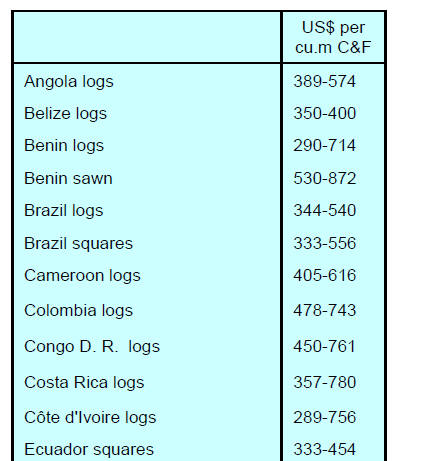
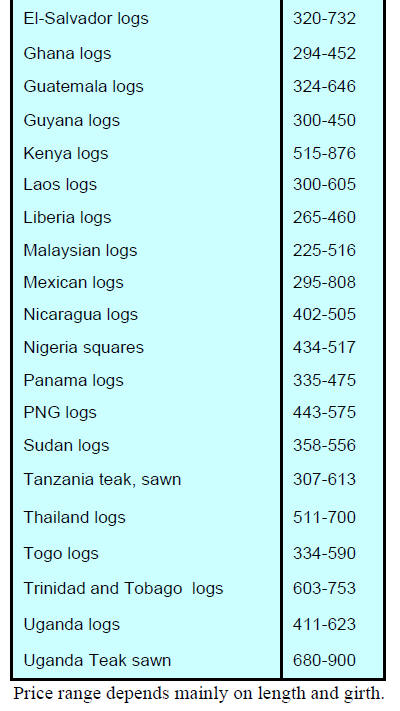
Locally sawn hardwood prices
Prices for imported sawn hardwoods remain unchanged.
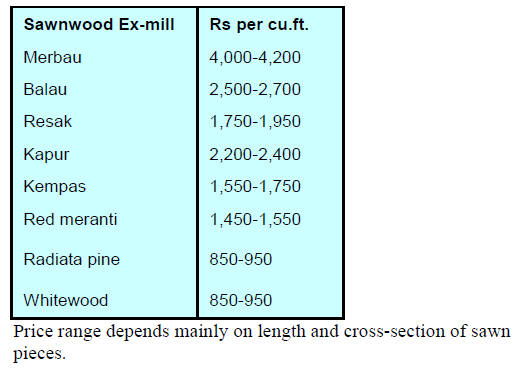
Myanmar teak prices
Analysts report that traders continue to complain they
cannot secure adequate supplies of Myanmar teak.
Prices for Myanmar teak continue as previously reported.
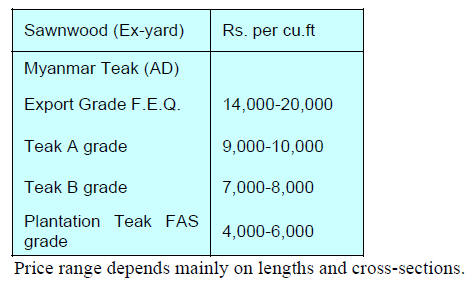
Sawn hardwood prices
In addition to efforts by US shippers those in Canada and
in some European countries such as Finland have
increased promotional efforts and this is delivering in
terms of rising sales. The diversification of sources has
helped keep prices stable.
Indicative prices for some imported timbers are shown
below.

Plywood
The importance of Gabon as a major supplier of veneer
and plywood is growing as production from new Indian
investment comes on-stream. The same applies to
shipmnets of sawnwood from Gabon to India.
Domestic plywood prices ontinue as previously reported.
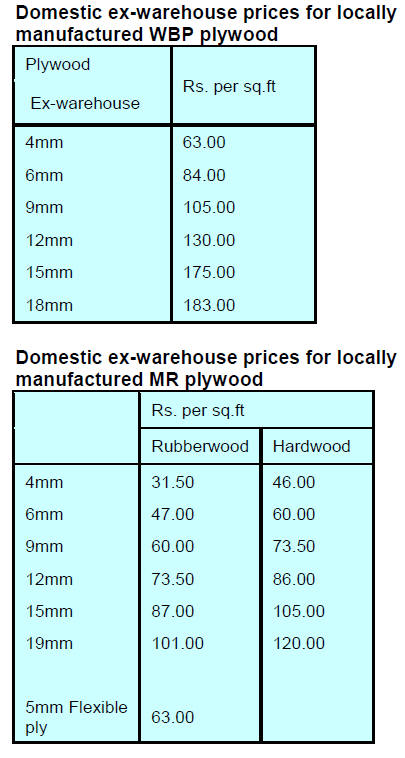
7. BRAZIL
SINAFLOR extensively used
across the country
The National System for Control of Origin of Forest
Product (SINAFLOR - Sistema Nacional de Controle de
Origem de Produtos Florestais) has been extensively used
across the country to verify permits for forest
management, land use change and production.
SINAFLOR data indicates that 5,244 approvals have been
issued since the system became mandatory in May 2018.
A further 2,500 applications are being processed.
The Brazilian Institute for Environment and Renewable
Natural Resources (IBAMA) conducts training courses to
support SINAFLOR and over 400 entrepreneurs,
consultants and public servants have been trained in the
states of Rondônia, Paraná, Paraíba, Alagoas and Roraima.
In February this year IBAMA inaugurated a distancelearning
training platform.
The need for an integrated national system for forest
control in the country was recognized in the 2012 Forest
Code. SINAFLOR controls the origin of timber, charcoal
and other forest products and by-products, tracking
permits for logging, transportation, storage, processing and
export.
More credit lines for forestry sector
In March this year the Timber Industry Union of Northern
Mato Grosso State (Sindusmad) hosted an event
"Financing the Production Chain for Sustainable Timber
Forest Management". Representatives of Banco do Brasil
were present and announced the bank would offer new
lines of credit specifically for the forestry sector.
This Sindusmad initiative builds on a partnership between
Banco do Brasil, the World Wide Fund for Nature
(WWF), Sindusmad and the Center for Timber Producers
and Exporters of Mato Grosso State (CIPEM). The aim is
to assist financing those committed to sustainable
utilisation of forests.
A spokesperson from Sindusmad pointed out that the
forestry sector has long sought credit lines for the
development of production. The forestry sector will now
have available credit lines for the entire production chain
including forest management, renovation of production
technologies, and working capital according to CIPEM.
International funds for Floresta-plus
Brazil will benefit from funding from the Green Climate
Fund (GCF) for successfully reducing greenhouse gas
emissions from deforestation. A GCF payment of US$96.5
million is based on the results achieved by Brazil in the
Amazon biome between 2014 and 2015, which were
endorsed by experts from the United Nations Framework
Convention on Climate Change (UNFCCC).
These funds are ear-marked for a pilot programme to
‘Incentivise Environmental Services for the Conservation
and Recovery of Native Vegetation’, or Floresta + to be
implemented by the Brazilian government with support
from the United Nations Development Program (UNDP).
Brazil has achieved significant emission reductions from
deforestation in the Amazon biome.
Export update
In February 2019, the Brazilian exports of wood-based
products (except pulp and paper) increased 3.2% in value
compared to February 2018, from US$244.2 million to
US$252.1 million.
The value of pine sawnwood exports increased just over
14% between February 2018 (US$38.8 million) and
February 2019 (US$44.3 million). At the same time export
volumes rose by almost 15% over the same period, from
186,200 cu.m to 213,700 cu.m.
Brazil’s tropical sawnwood exports rose almost 28% from
31,100 cu.m in February 2018 to 39,700 cu.m in February
2019 but the value of exports only rose 13% from
US$14.2 million to US$16.1 million, over the same
period.
In contrast, pine plywood exports declined 6.3% in value
in February 2019 compared to February 2018, from
US$57.1 million to US$53.5 million but there was an
increase in export volumes from 175,200 cu.m to 195,600
cu.m in the same period.
Brazil’s exports of tropical plywood remain small and in
February export volumes dropped from 12,700 cu.m
(US$5.2 million) in February 2018 to 10,800 cu.m
(US$4.0 million) in February 2019.
On a brighter note, exports of wooden furniture in
February increased from US$38.8 million in February
2018 to US$40.4 million in February 2019.
Furniture exports rise in Rio Grande do Sul
The decline in domestic demand for furniture during the
recent economic crisis in the country which saw the US
dollar appreciate strongly against the Brazilian currency
resulted in many manufacturers in Bento Gonçalves to
turn their attention to international market.
In 2018, furniture manufacturers in Bento Gonçalves, Rio
Grande do Sul, earned US$42.6 million from exports a
12.5% increase over 2017 according to Bento Gonçalves
Furniture Industry Union (Sindmóveis).
In the first two months of 2019 companies in the region
sealed export contracts worth US$61 million an increase
of 34.4% over the same period of the previous year.
Sindmóveis estimates that international sales for 2019 are
expected to grow by 14% to about US$50 million.
The Latin American countries are the main destinations
for furniture produced in Bento Gonçalves. Uruguay was
the biggest buyer last year, followed by Peru and Chile.
Latin American markets are attractive to companies in
Bento Gonçalves because the competition is lower than in
Europe.
However, countries like Saudi Arabia and the United
States are good markets and in the first two months of
2019 the main export markets were in North America.

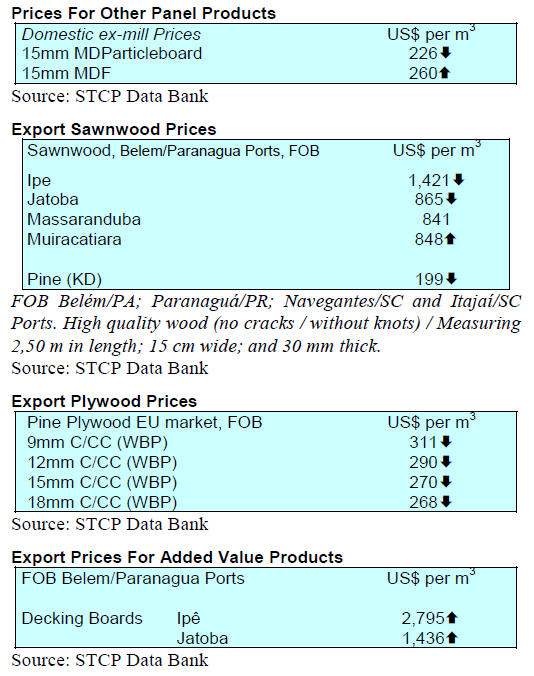
8. PERU
Industrialisation could help
eliminate illegal
logging
When meeting the media the Vice President of the
Association of Exporters (ADEX), Erik Fischer, said the
country suffers the loss of thousands of hectares of forest
annually as a result of unsustainable activities and called
for a new approach to the fight against illegal logging.
He suggested that prioritising domestic manufacturing
could be part of the solution as job security would be a
driving force behind sustainable harvesting.
He added that in 2018 manufacturers in the sector added
almost 30,000 direct and indirect jobs, around 3% more
than in 2017. This number could increase significantly if
forestry concessions are managed sustainably. He pointed
out that Peru has 17 million hectares of forests earmarked
for production but 3 million hectares are currently being
harvested.
Sernanp and Osinfor cooperation agreement
The National Service for Natural Protected Areas in the
State (Sernanp) and the Wildlife Resources and Wildlife
Oversight Agency (Osinfor) signed an inter-institutional
cooperation agreement that will promote joint action for
the conservation of forests nationwide.
Through this strategic alliance between both agencies in
the Ministry of the Environment the conservation and
sustainable use of forest resources will be promoted
through the exchange of experiences and information to
optimise the efficiency and effectiveness of each entity
objectives.
Loreto export potential boosted through updated
export plan
Edgar Vásquez, Minister of Foreign Trade and Tourism,
handed the Regional Governor of Loreto the Loreto
Regional Export Plan (PERX Loreto), a document that
will serve to boost exports from this important region to
the northeast of the country.
The Loreto Region has great export potential especially
for wood products, cocoa and camu camu said the
minister.
